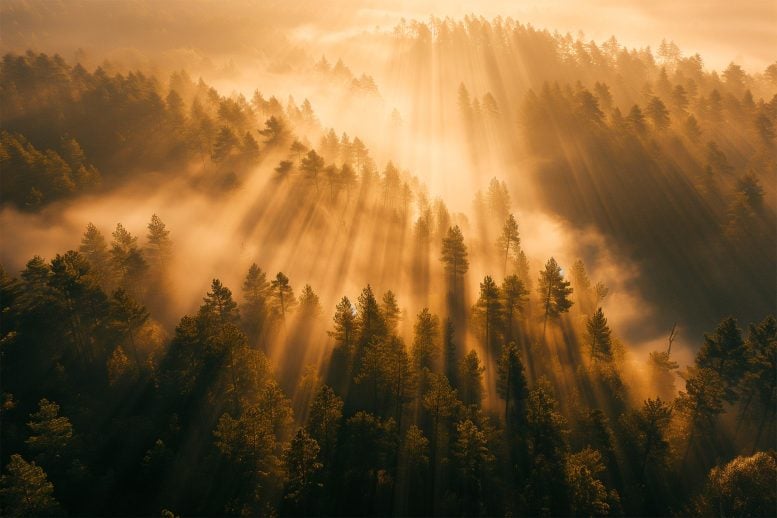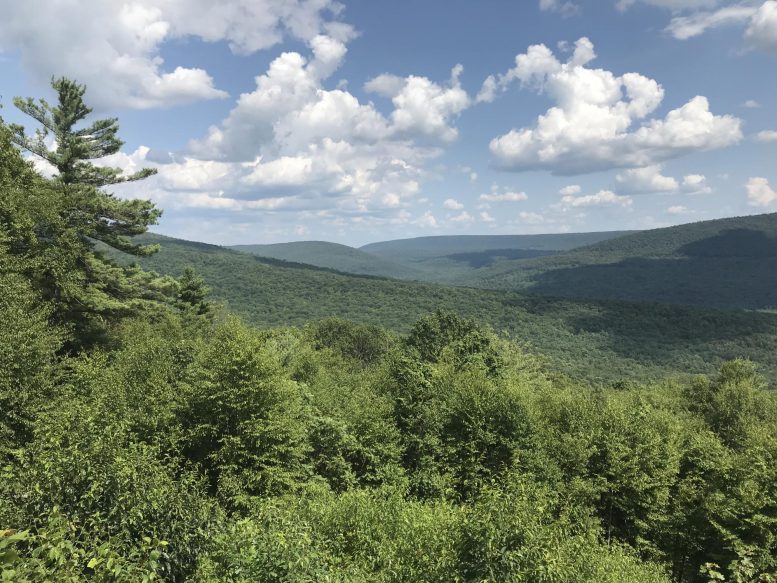
Recent research from Penn State suggests that trees in warmer, drier environments struggle to absorb carbon dioxide, harming their ability to cope with climate change. The study highlights an increase in photorespiration – a process in which stressed trees release carbon dioxide – under these conditions, challenging the effectiveness of trees as natural carbon sinks in a warming world. Credit: SciTechDaily.com
Trees struggle to sequester heat-trapping carbon dioxide in warmer, drier climates, meaning they may no longer serve as a solution to offset humanity's carbon footprint as the planet continues to warm, according to a new Penn State-led study. Researchers.
“We found that trees in warmer, drier climates cough instead of breathe,” said Max Lloyd, an assistant research professor of geosciences at Penn State and lead author of the study recently published in the journal Science. Proceedings of the National Academy of Sciences. “They release much more carbon dioxide into the atmosphere than trees in cooler, wetter conditions.”
Through a process PhotosynthesisTrees remove carbon dioxide from the atmosphere to produce new growth. However, under stressful conditions, trees release carbon dioxide into the atmosphere, a process called photorespiration. By analyzing a global dataset of tree tissue, the research team demonstrated that the rate of photorespiration is up to two times higher in warmer climates, especially when water is limited. They found that the threshold for this response in subtropical climates begins to be exceeded when average daytime temperatures exceed approximately 68 degrees. F It gets worse as temperatures rise further.
The complex role of plants in climate adaptation
The findings complicate common belief about the role of plants in helping to pull or use carbon from the atmosphere, providing new insight into how plants adapt to climate change. More importantly, the researchers note that as the climate warms, their findings show that plants may be less able to pull carbon dioxide from the atmosphere and absorb the carbon necessary to help the planet cool.
“We've thrown this fundamental cycle off balance,” Lloyd said. “Plants and climate are closely linked. The biggest pull of carbon dioxide from our atmosphere is by photosynthetic organisms. It's a big key to the composition of the atmosphere, meaning small changes have a big impact.”
Lloyd explained that plants currently absorb an estimated 25% of carbon dioxide emitted by human activities each year, according to the US Department of Energy, but this percentage is likely to decrease in the future as the climate warms, especially if water becomes scarce.
“When we think about climate futures, we expect carbon dioxide to rise, which in theory is good for plants because those are the molecules they breathe,” Lloyd said. “But we have shown that there will be a trade-off that some mainstream models do not take into account. The world will become warmer, which means plants will be less able to pull in carbon dioxide.

By analyzing a global dataset of tree tissue, a team led by Penn State researchers demonstrated that the rate of photorespiration in trees is up to two times higher in warmer climates, especially when water is limited. They found that the threshold for this response in subtropical climates, such as this part of the Appalachian mountain range and the Valley region, begins to be exceeded when average daytime temperatures exceed about 68 degrees Fahrenheit and worsens as temperatures rise further. Credit: Warren Reed/Penn State
In the study, the researchers discovered that variation in the abundance of certain isotopes of a part of wood called methoxyl groups acts as a tracer of photorespiration in trees. Lloyd explained that you can think of isotopes as different types of atoms. Just as you might have vanilla and chocolate versions of ice cream, atoms can have different isotopes that have their own unique “flavors” due to differences in their masses. The team studied methoxyl isotope “flavor” levels in wood samples from about three dozen tree specimens from a variety of climates and conditions around the world to observe trends in photorespiration. The samples came from the archives at University of California, Berkeleywhich contains hundreds of wood samples collected in the 1930s and 1940s.
“The database was originally used to train foresters how to recognize trees from different places around the world, so we repurposed it to essentially reconstruct these forests to see how well they absorbed carbon dioxide,” Lloyd said.
Until now, rates of photorespiration could only be measured in real time using living plants or well-preserved dead specimens that retained structural carbohydrates, meaning it has been nearly impossible to study the rate at which plants sequester carbon on a large scale or in the past. Lloyd explained.
Looking to the past to understand the future
Now that the team has validated a method for monitoring the rate of photorespiration using wood, he said the method could provide researchers with a tool to predict how well trees will “breathe” in the future and how they have performed in past climates.
The amount of carbon dioxide in the atmosphere is rising rapidly; It is already larger than at any time in the past 3.6 million years, according to National Oceanic and Atmospheric Administration. Lloyd explained that this period is relatively recent in geological time.
The team will now work to discover rates of photorespiration in the ancient past, up to tens of millions of years ago, using petrified wood. These methods will allow researchers to explicitly test existing hypotheses regarding the changing impact of plant photorespiration on climate over geological time.
“I'm a geologist, working in the past,” Lloyd said. “So, if we're interested in these big questions about how this cycle worked when the climate was very different than it is today, we can't use living plants. We probably have to go back millions of years to better understand what our future will look like.”
Reference: “Isotopic clustering in wood as an alternative to photorespiration in trees” by Max K. Lloyd, Rebekah A. Stein, Daniel E. Ibarra, Richard S. Barclay, Scott L. Wing, David W. Stahle, Todd E. Dawson and Daniel A. . Stolper, November 6, 2023, Proceedings of the National Academy of Sciences.
doi: 10.1073/pnas.2306736120
Other authors on this paper are Rebecca A. Stein, and Daniel A. Stolper, and Daniel E. Ibarra, and Todd E. Dawson of the University of California, Berkeley; richard s. Barclay and Scott L. Wing of the Smithsonian National Museum of Natural History, and David W. Stahl of the University of Arkansas.
This work was funded in part by the Aguron Institute, the Hyssing-Simons Foundation, and the US National Science Foundation.

“Beer aficionado. Gamer. Alcohol fanatic. Evil food trailblazer. Avid bacon maven.”
